Knossos Palace: Honest Visitor Review, Heat Tips & Best Time to Go
Welcome to Knossos Palace, the birthplace of Minoan legend and the Minotaur’s Labyrinth. While every stone here tells a captivating story of ancient civilization—and we provide all the essential, authoritative history—this guide is uniquely built on our first-hand experience.
We go beyond myths and generic advice to deliver crucial, verifiable on-the-ground tips on subjects often ignored by guidebooks: from parking accessibility and how to find a guide on the spot, to our proven strategy for managing the intense August sun.
This is your complete journey, combining expert historical knowledge with practical, photographic evidence for your Crete adventure.
Table of Contents
Logistics and Our First-Hand Experience
With the historical importance of Knossos established, we now pivot to the crucial details that will define your visit. This section is dedicated entirely to the practical, on-the-ground tips we gathered from our experience, tackling logistical challenges like managing the intense summer heat, organizing transport, and choosing a guide.
These suggestions, backed by our photographic evidence, are designed to help you transform a potentially stressful day into a comfortable and unforgettable exploration.
Reaching Knossos: Why a Rental Car is the Best Choice
Given the fame of Knossos—an iconic image seen in virtually every history book—a visit is a must-do if you are near Heraklion. Based on our trip, renting a car was the absolute game-changer. It gave us the essential freedom to move around Crete without being restricted by bus schedules or pre-booked transfers, allowing us to perfectly fit the visit into our daily itinerary.
If you choose to drive, you’ll find parking is surprisingly easy right near the entrance, so you don’t need to stress about searching for a spot. The parking for the archaeological area of Knossos is very large and free. However, whether you drive or take a taxi, timing is fundamental. Being so popular, it’s much better to arrive early, especially in the peak season, because big crowds can fill it. Arriving early, you don’t risk finding it full.
Is there parking available at Knossos Palace?
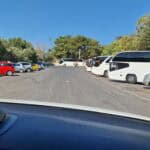
Yes, there is easily accessible parking right near the site entrance. We chose to rent a car for the freedom it offers, and based on our experience, parking was simple and convenient. However, our crucial tip is to arrive early in the morning (especially during high season like August) to ensure you secure a spot, as the lot fills up quickly as the day progresses.
Our Crucial Tip: Beating the Heat and the August Crowds
We visited in August, the peak of the tourist season, which means two things: intense crowds and intense heat. To fully enjoy Knossos, you must go early in the morning. Arriving early solves both problems: you secure your parking spot before the rush and, most importantly, you avoid the sweltering afternoon sun.
Given that there is very little shade within the archaeological site, going in the morning is crucial for a comfortable exploration. In fact, there might be a tiny, covered section inside the ruins, but it is very little and offers minimal relief. As our final photo clearly demonstrates, during the midday heat, visitors who need a break gather outside the main site area, crowding the tiny patches of shade provided by the few available trees. Plan your timing wisely to avoid this!
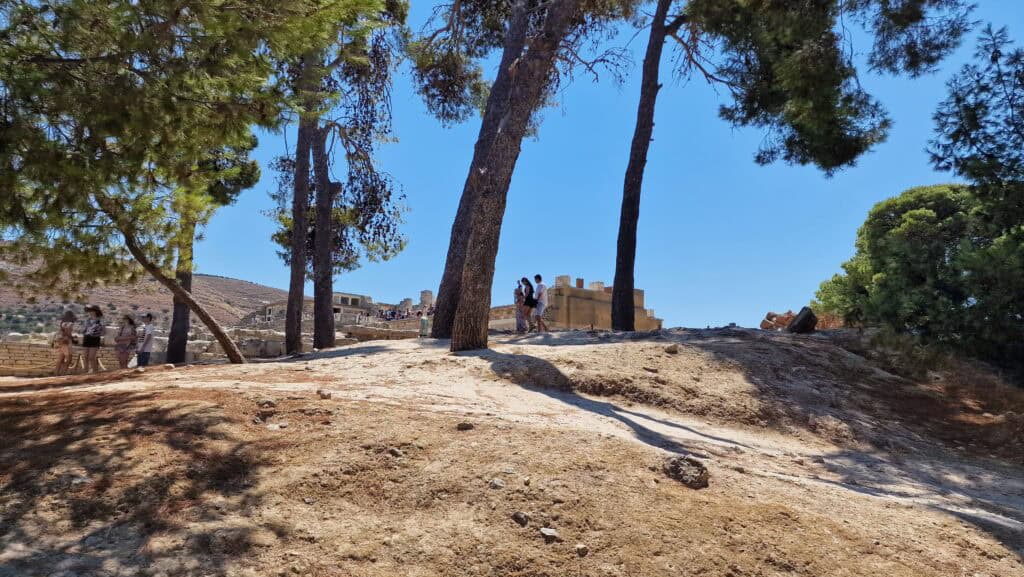
What should I wear when visiting Knossos in the summer?

Since the archaeological site offers very little natural shade, preparation is key, especially if you visit during the hot summer months (June–August). We strongly recommend wearing light-colored, loose clothing, applying sunscreen generously, and crucially, wearing a hat or cap to protect yourself from the direct sun. Sunglasses and comfortable walking shoes are also a must.
II. The Guided Tour: An Unexpected Success
3. Should You Get a Guide? Our Experience vs. an Audio Guide
We arrived without pre-booking a guided tour, and this worked out perfectly. A guide approached us at the site and quickly formed a small, restricted group with other visitors. This is a huge advantage: the flexibility to go there and decide on the spot whether to join a tour or not.
While I sometimes prefer self-guided tours or audio guides, at Knossos, having a live human guide was infinitely more useful. The personal guidance proved to be invaluable. The key difference here is that the value lies not only in the physical ruins but in the history being narrated.
Do I need to book a tour guide in advance?
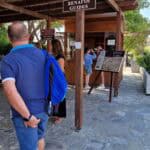
Based on our experience, no, you don’t necessarily have to. In major tourist sites like Knossos—and other famous locations we’ve visited, such as Pompeii, Herculaneum, or even the Cathedral in Seville—it is common to find professional guides waiting near the entrance area. This is their established workflow, and they are usually ready to form small groups on the spot, as we successfully did at Knossos. This flexibility is great if you are unsure about getting a guide beforehand.
However, organizing in advance is never a bad thing. If you have specific language requirements, need a private guide, or have particular needs, pre-booking your guide is always the best way to ensure your specific preferences are met. But generally, these major sites are well-organized, and finding a guide upon arrival is not usually a problem.
4. Why the Guide is Essential: Bringing Reconstructions to Life
The reason the guide is so vital here relates directly to the nature of the ruins. As is well known, many parts of the site have been heavily reconstructed (by Arthur Evans). The true interest of Knossos comes from understanding the history; the guide brings the story to life, which is essential. They provide historical references and point out crucial details that could easily escape an untrained eye, preventing the visit from becoming a mere look at reconstructions.
This contextualization is what gives the visit its true value. You are not just looking at reconstructed stones; you are accessing the story, the culture, and the significance that makes the site exceptional.
Amenities Near Knossos: Finding Food and Water in a Desolate Landscape
We chose not to eat there because we had the freedom of our rental car and preferred to move on to other locations in Heraklion. However, if you need a quick snack, water, or have specific needs, you are well-covered. This reassures visitors that they don’t have to worry about basic provisions right before or after their visit to this famous archaeological site.
A key logistical point is the availability of amenities. Although Knossos Palace is not located in the city center, the immediate entrance area is certainly not isolated. As you can see in our photo, this small area is vibrant with various activities, including stalls, shops, and a few small restaurants.

However, it is crucial to note the contrast in the landscape: just beyond these commercial activities, the surroundings are largely desolate and rocky, reflecting the remote nature of the archaeological site itself. This means that while you don’t need to worry about basic needs right near the entrance, you must still be prepared for the exposed environment once inside the ruins.
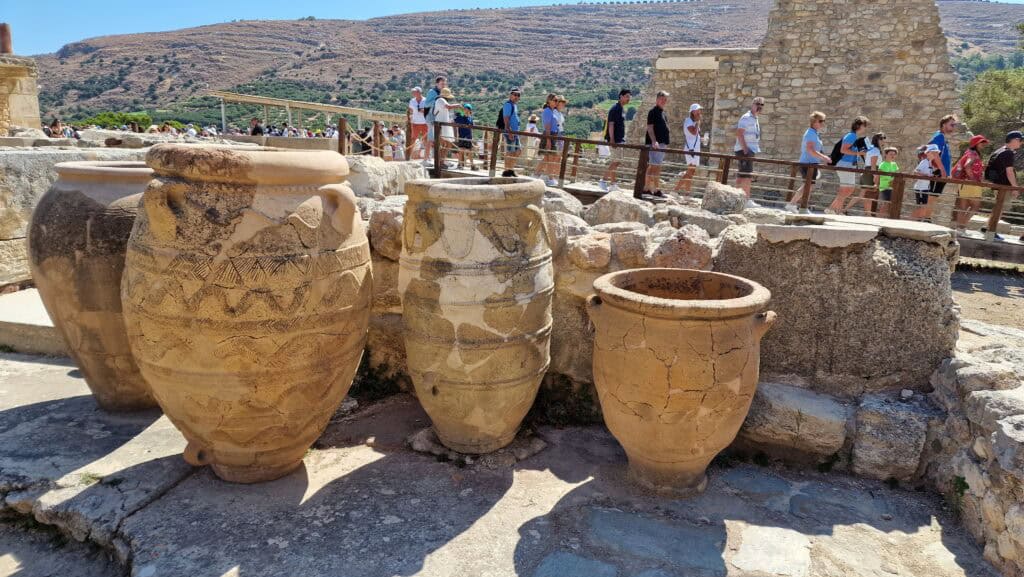
Official and Up-to-Date Information (Hours and Tickets)
Travel details like opening hours and ticket prices are subject to change by the government. To ensure you have the most current information, including seasonal variations and special free admission days, we highly recommend checking the official source directly:
Official Knossos Palace Page – Hellenic Ministry of Culture and Sports
History and Facts
What are the inhabitants of Knossos called?
The Minoan civilization lived in Knossos. We can therefore call the inhabitants of Knossos Minoites.
Is what we see in Knossos original or fake?
Is what we see in Knossos original or fake? To answer this question, let’s first understand what we see during our visit to Knossos.
The palace we see today is the palace from 1700 BC. This palace was built on the ruins of the old palace. The only remaining parts of the old palace are the western courtyard, the warehouses and the theater. These parts were refurbished and reused until the end of the Minoan era. The rest of the old palace with its ruins was instead covered with earth after the earthquake of 1700 BC and the new palace was built exactly above.
It must be said that even the palace we see today, the palace of 1700 BC, has been damaged many times by earthquakes, the eruption of the volcano of Santorini in 1500 BC and the invasion in 1450. However, immediately after each destruction, the palace was renovated and re-inhabited.
This is true until 1360 BC, when the last great destruction was due to an earthquake, followed by a fire in the warehouses. In fact, the warehouses contained amphorae that contained oil and wine. The contents of these amphorae were overturned and due to the earthquake, they caught fire by the lamps that illuminated the warehouse. First, the warehouse caught fire and then the whole building. The fire burned all the wooden parts and since the columns were also made of wood, the whole building collapsed.
For this reason, there is nothing original in Knossos above the first horizontal beam. After the earthquake of 1360 BC, the palace was no longer restored, but the city of Knossos remained inhabited until 67 BC, when it was destroyed by the Romans. In fact, the Romans no longer needed a large city in the north and changed the sea routes. Their ships passed along the southern coast. They moved the capital of the island to the south, about 70 km from Knossos, where the ruins of the ancient city still stand today, which are located near Phaistos in southern Crete.
But until Roman times, Knossos was the capital of Crete.
Why do we see well-preserved parts of the palace of Knossos today?
If it is true that the Palace of Knossos collapsed, why do we see well-preserved parts of the palace today? To answer this question, let’s first try to figure out who started excavating the ruins of the palace of Knossos.
The first to excavate at Knossos was Arthur Evans, who carried out restoration, not of a conservative type but rather tried to reconstruct some parts of the palace according to his idea of how it could be. In addition, he uses materials that are not faithful to the originals and unrelated to the original construction of the palace of Knossos.
His method is clearly criticized by modern archaeologists, although tourists are very attracted to these reconstructed parts, and are among the most photographed.
So some parts of the palace that seem well preserved, especially those with red columns, are actually a reconstruction by Evans. Other parts of the building, such as the warehouses, are original.
Why had they chosen this place to build the city of Knossos?
Why had they chosen this place to build the city of Knossos? The city of Knossos was located not on the sea but at a certain distance. This allowed it to be protected in case of direct attacks from the sea.
It was also located a little high so that you could control and observe the land around it. There was a natural fortification formed by all the hills around, plus it is a fertile area and there was water nearby. For all these reasons, this place was chosen for the construction of Knossos.
Are there any frescoes in Knossos?
While visiting the ruins of Knossos, you will see some frescoes. These frescoes are copies and are not originals, as the originals are kept at the Heraklion Archaeological Museum.
In any case, the frescoes of Knossos are beautiful to see as different colors were used and from these frescoes, we can learn about different aspects of the life of the inhabitants of this city.
The colors were extracted from plants, shells, minerals, the walls from which they took the dust, and the bones of burnt black animals and imported the blue from Egypt. They painted the men red and the women white. The women were white, perhaps to clarify that they didn’t go out often, didn’t work in the fields, and were therefore not tanned.
Gold and wooden items were painted yellow, while silver items were painted blue. Silver items such as vases, bracelets, and anklets.
From the information we have, we can say that the people represented here in the painting are men in fact, they are painted in this reddish color, they hold various objects, some of which are silver as they are blue.
These were priests dressed in their typical priestly robes. The priests depicted in the paintings are always dressed like this: with a short embroidered skirt with colorful designs. The skirt was probably made of very fine fabric or was very wide because a net with small silver weights at the bottom hung in the final part of the skirt. This was to prevent the skirt from being raised even on windy days.
The rest of the man’s body was naked. In the frescoes, all these men are represented with narrow waists and broad shoulders but in reality, we can say that they were not like that. In fact, observing the skeletons found, they were not even very tall, around one meter and 60 cm. The women were instead others around the meter and 50 cm. There were also taller men but generally, they were shorter and not as slender as we see them on the frescoes.
In the processions, there was a line of men coming from one direction and another procession of men coming from the opposite direction and in the center between the two lines, there was a white woman waiting to receive the offerings contained in the vases.
The rooms we see have been reconstructed and even the columns are not original, but we still see the ancient alabaster base under the columns.
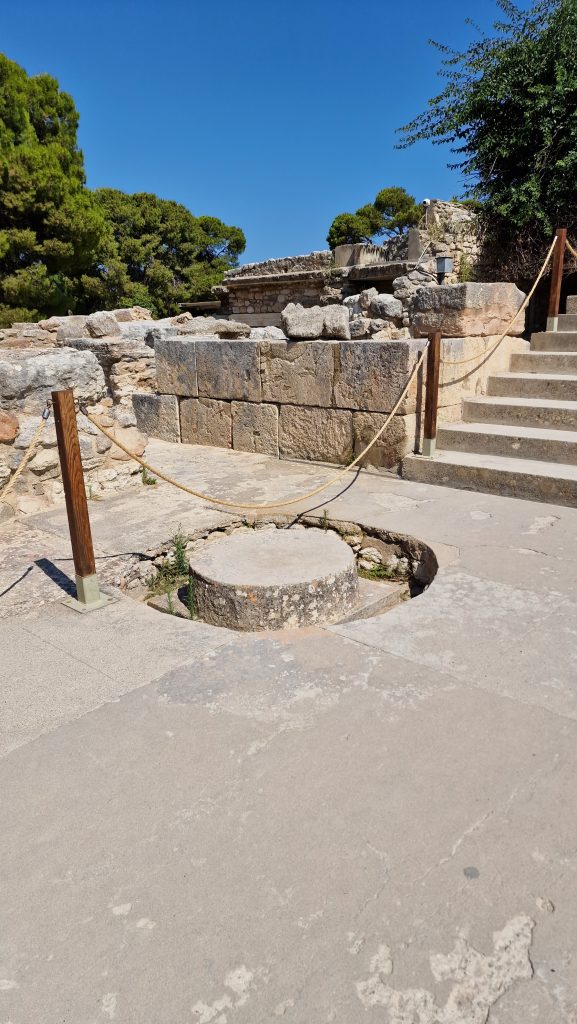
How do we know how tall the rooms were?
If we don’t have columns and how do we know how tall the rooms were?
The rooms were a maximum of 3 meters high as this is the height of the stairs leading to the upper floors.
The bull as a symbol of power
The bull was, for the inhabitants of Knossos, a sacred animal, a symbol of power. According to Evans, the double horns symbolized the king’s double power: religious power and legislative power. The horns were placed on the roofs of the rooms (Evans’s theory) or on his drawings. The horns were a symbol indicating the sacred character of a part of the palace.
The western courtyard and the processions
On your visit to Knossos, one of the first areas you come across is the western courtyard. It must be said that seeing it without an explanation, we cannot understand its function or importance.
The courtyard is crossed by three corridors raised above the rest of the pavement and they intersect each other. The idea is that processions would parade over them during the ceremonies.

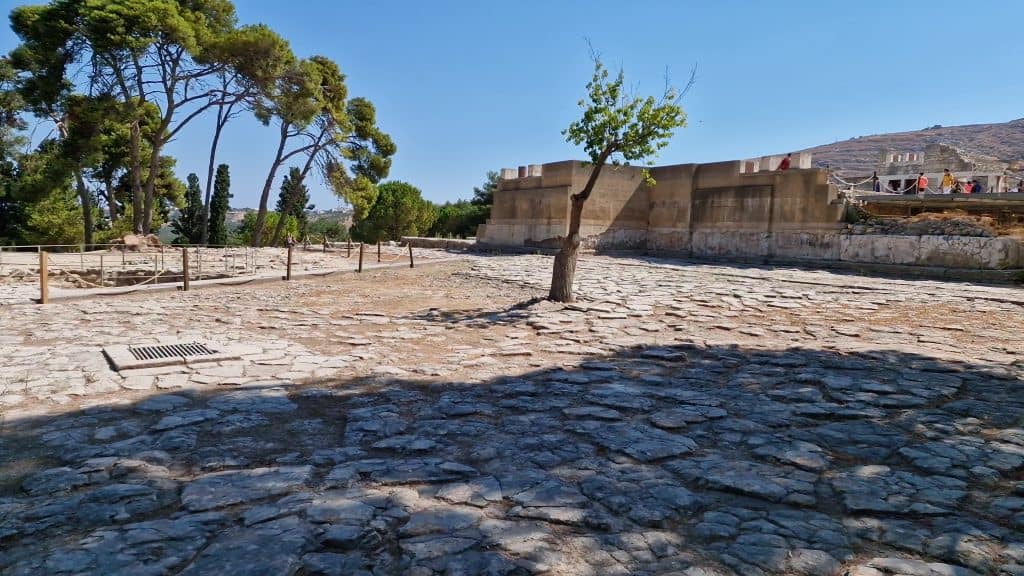
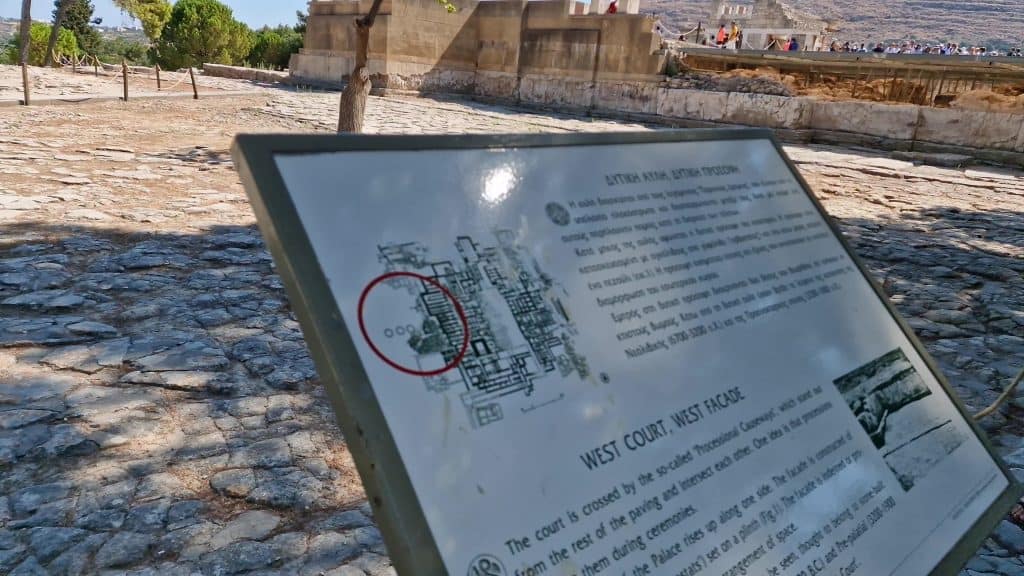
You can clearly see these corridors from the model of Knossos that you find at the Heraklion museum.
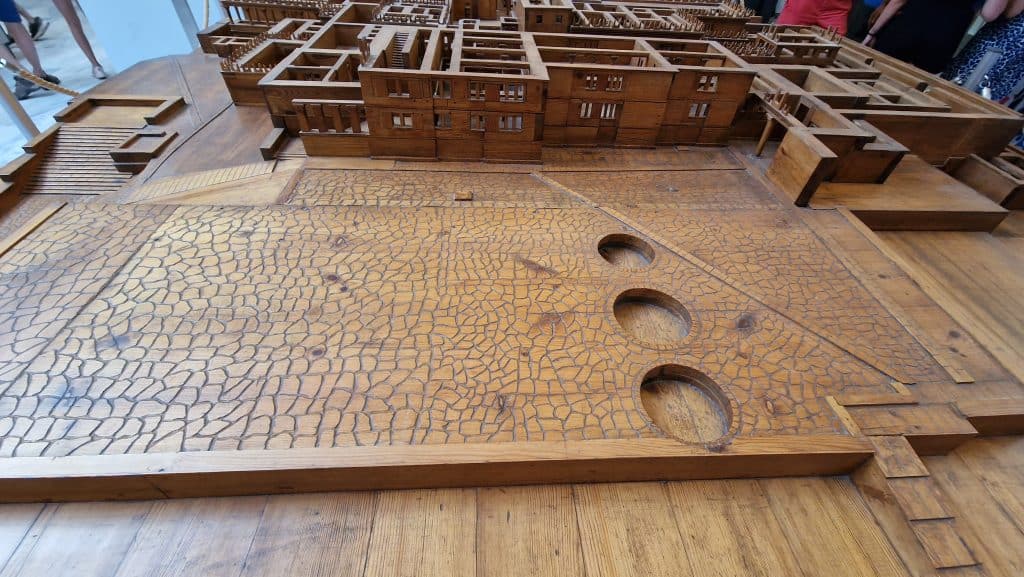
We must rely on the images depicting these scenes to know how the processions took place, as we have not yet understood the Minoan script.
For this reason, a sarcophagus kept at the Heraklion Museum is very important because it shows us a procession like those that probably took place right here in the western courtyard.
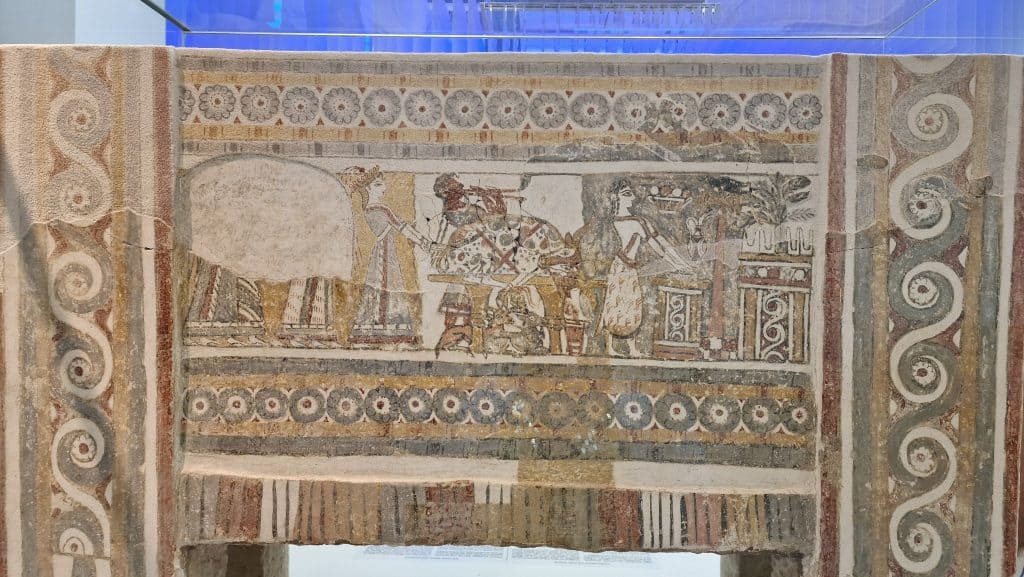
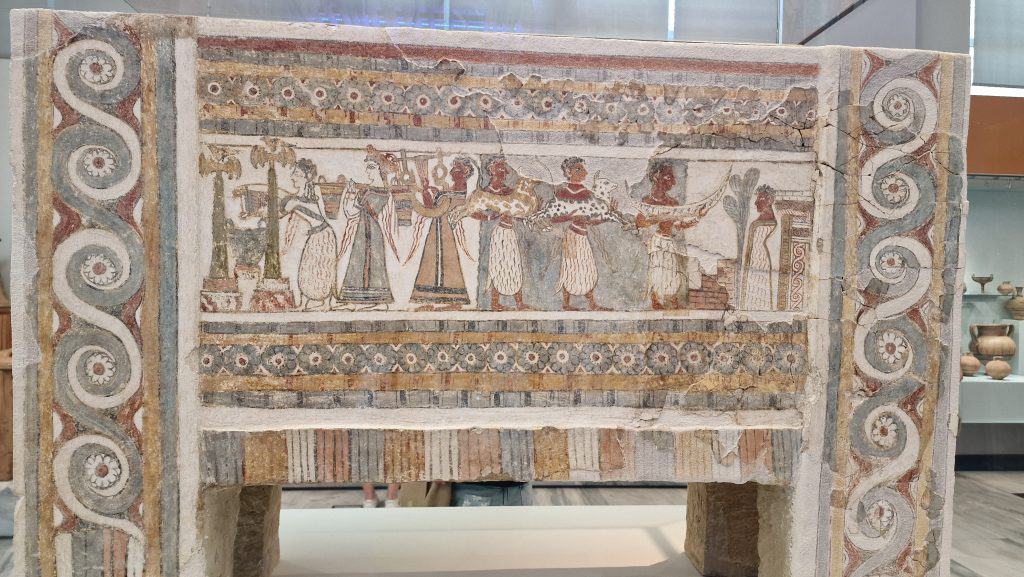
The warehouses
The warehouses kept large amphorae in which products such as wine, olive oil, and honey could be placed.
The size of the Knossos warehouses makes us understand that they could satisfy more than just the needs of the inhabitants of Knossos. In fact, all the products collected in the neighboring lands were probably brought into the palace and from there distributed to the inhabitants or exported to other countries.
This makes us understand that the palace of Knossos was also a commercial center.
The warehouses were rectangular rooms generally covered and closed. Two sets of amphorae were placed near each room’s long walls. In the warehouses where the products were liquid such as wine and oil, there were holes in the ground or small square or rectangular tanks, a maximum of 1 meter and 20 cm deep, with an internal alabaster lining.
These small cisterns had the task of collecting the contents of the amphorae when they broke for any reason: for an accident or an earthquake, for example. In this way, even if all the vessels were destroyed at the same time, at least some of the products were collected in these tanks and not lost. The product could then be filtered and reused.
The religion of the Minoan civilization
The inhabitants of Knossos were monotheists until at least 1500 BC. In fact, the museum contains clay tablets written with the writing used in Crete after 1500 BC that mention 3 gods of Olympus: Dionysus, Poseidon and Zeus.
It is therefore evident that these 3 gods were introduced from Greece around 1500 BC with the arrival of the Mycenaeans from the Peloponnese, who brought with them the worship of their gods. The worship of these gods accompanied the worship of the Minoan goddess who was previously worshiped.
The worship of the mother earth of the Minoites continued until 1100 BC, but this adoration was accompanied by the adoration of the other 3 gods after 1500 BC.
The Minoites organized ceremonies and processions and sacrificed animals for their divinity. Everyone could go to the palace’s sanctuary: palace inhabitants, Cretans, and foreigners. In fact, alabaster vases built in Egypt have been found with hieroglyphic inscriptions that also bear the names of the pharaohs.
People brought their offerings to propitiate the goddess’ favor or as thanks. Animal models in ceramic and bronze were found brought, perhaps by shepherds who wanted to ask for something for their animals.
Then some ex-votos were found to be very similar to those that are still carried in churches today. Today, in fact, gold or silver tablets are brought to represent parts of the body for which healing is requested. The Minoites did not have tablets of gold or silver but small ceramic objects in the shape of the part of the body for which healing was sought.
The double ax
The double ax was the most important symbol of the Minoan civilization. More than 2000 double axes of different materials, weights and sizes have been found here in Knossos. The double axes were used for different purposes depending on the size and material.
The medium-sized ones were used for animal sacrifices, and the larger ones supported by stone and wooden bases served as ornament inside the palace or stood in front of the sanctuaries. Smaller gold ones were hung around the neck, perhaps as a sacred symbol of the Minoan religion as crosses are used today. In fact, some still retain a ring on one side from which they passed a chain or a cord to form a pendant to wear around the neck.
The double ax symbol was also engraved on the walls of the rooms.
What is the Knossos labyrinth actually?
We have just seen how widespread and important the double ax symbol was in Knossos. This symbol is also connected to the very term labyrinth. How?
We know that the ancient name of the double ax was lábrys. It is said that the Greek word labyrinthos or labyrinth in Italian derives from this ancient word. Labyrinth is a word made up of two others: lábrys, which is the name of the double ax and inthos which means place or locality. Labyrinthos then meant the place of the lábrys, the house of the double ax.
Probably this was the name given to the palace of Knossos by the Mycenaeans or by the Greeks, who saw this palace full of double axes and called it labyrinth.
Perhaps later, this term was used by others who wanted to describe buildings similar to the palace of Knossos. In fact, the palace was large and complicated, all complicated constructions were called that. Gradually the word lost its ancient meaning and took on another meaning, first in Greek and then in other languages.
For archaeologists, the labyrinth was the great building of the palace of Knossos.
The labyrinth of Knossos according to mythology
According to mythology, the labyrinth was instead a construction made by an architect from Athens: Daedalus. Minos had ordered Daedalus to build a prison for the minotaur: the queen’s son and a white bull that Poseidon had sent as a gift to Minos.
After the scandal that broke out in Knossos for the birth of the monster, Minos ordered Daedalus to build the labyrinth. Inside the labyrinth, the monster was imprisoned: the minotaur.
Daedalus and his son Icarus were not allowed to leave the island of Crete not to reveal the labyrinth’s secret. They then escaped with wax wings built by Daedalus but while they were flying over the islands of the Aegean sea, Daedalus Icarus’s son got too close to the sun. His wings melted, he fell into the sea and died.
Since then, a part of the Aegean sea bears his name: Icarion sea, with the island of Icaria formed exactly in the place where Icarus lost his life.
This is the story of the labyrinth. According to mythology, the labyrinth is the place where the minotaur ate 7 boys and 7 girls from Athens every year. The place where Theseus, the prince of Athens, entered using Ariadne’s thread, killed the minotaur, and then found his way out using the thread.
All these myths were invented many years after the end of the Minoan era, probably by people who wanted to describe something they had heard and passed down from their ancestors to explain what happened in antiquity.
What is the origin of the myth of the arrival of Theseus?
What is the origin of the myth of the arrival of Theseus? Archaeologists say that the myth of the arrival of Theseus, a Greek and the killing of the monster may be an indication of an invasion by the Greeks. There is the theory that in 1450 BC the Mycenaeans, or the Greeks, destroyed the palace.
Where does the myth of the Minotaur originate from?
Where does the myth of the Minotaur originate from? The myth of the monster, of the minotaur who lived in Crete and ate 7 boys and 7 girls from Athens every year, was probably invented to describe bullfighting.
Bullfighting was a Minoan game in which a wild and untrained bull participated. The people hunted the bulls in the plains where they lived and took them to the place where these games were played. The games were also attended by athletes who could be both men and women, as we can also see in the fresco: some figures are white while one is red.

We recall as already mentioned above that in the frescoes the women were colored white, the men instead of this reddish color.
The athletes depicted in the games are all dressed alike, with a uniform consisting of short shorts.
At the start of the games, the athlete had to take the bull by the horns as the bull ran toward him, then he had to jump over his back, and eventually, he had to jump back and stay standing. As you can see, they were very difficult games.
The games aimed not to kill the bull but to do stunts over its back. The bull was a sacred animal, and they sacrificed it on other occasions but not during games.
Bull athletes died much more often. This is especially true for athletes who came from afar, as they were very young, did not have the opportunity to train and did not have a lot of experience in this type of game. For this reason, they were very often injured and killed by the bull’s horns.
Probably the invention of the myth of the Minotaur, or a myth that spoke of a monster who lived in Knossos and who ate 7 boys and 7 girls from Athens every year, was just a way that the Athenians had found to describe these Cretan games that they seemed cruel to them.
The minoites and sport
The Cretans were lovers of games and sports as we can see from the frescoes depicting muscular men. In addition to the acrobatics on the bulls on the frescoes, there are running competitions where not only red Minoite men participate but also black and, therefore African men who probably came up here to participate in the races. There were also wrestling and boxing competitions.
The fresco of the Prince of Lilies also probably represents an athlete. Evans thought he was a prince but he probably wasn’t. In fact, he is dressed like an athlete, he has a very muscular body, and his right hand is in a fist. Perhaps he was an athlete in a fight scene, not a prince as Evans called him.
The fresco of The Prince of the Lilies
The man represented in this fresco is an exception to the rule as he is a man but does not have a red color like on the other frescoes. In fact, the color used is pink, an orange-pink.
At the turn of the century, Evans said that the younger members of the royal family were painted pink and for this, he called him prince. In particular, the name Prince of the Lilies was given to him for his crown, decorated with lilies and peacock feathers, and the necklace with red lilies.
The original fresco is kept in the museum. However, some parts of it are not original and have been added and reconstructed by archaeologists.
An important detail to note is that we only have a small part of the left arm so the movement has been completely reconstructed. Evans thought it was a prince pulling an animal, so the arm was placed in a position that depicted this scene, so in the reconstruction, the arm is outstretched.
However, nothing indicates that the arm was in a different position.

In fact, modern archaeologists think that he is not a prince but an athlete: he is dressed like an athlete, has a very muscular body and his right hand is in a fist.
So maybe he was an athlete in a fight scene and the other arm was also in a wrestling position. Therefore an athlete and not a prince as Evans called him.
However, this relief painting is still known today as the Prince of the Lilies and is the most famous painting among those found. To be able to do this type of painting, the artist first had to apply stucco on the wall giving the desired shape and then, while the stucco was still wet, he had to apply it very quickly, perhaps with a sponge, all the colors that were absorbed by the stucco.
This technique allowed the colors to last over time and are still preserved.
The throne room
The throne room is one of the most visited areas of the palace of Knossos. In the throne room, there is the stone turret adjacent to a wall and benches all around where people could sit to talk to the king. On the wall, a painting was found showing palm leaves and griffons, mythical animals imagined by Minoites with the head of an eagle, the body of a lion and a snake as a tail. This composition of the griffon perhaps indicated the 3 powers worshiped in Crete: the powers of the air or of the sky with the eagle, of the earth with the lion and the underground powers with the snake.

According to Evans, the throne room was probably used when the king acted as a priest because this room is connected to the sanctuaries. Probably inside the throne room, the king received other priests and together they purified themselves, before leaving for the ceremonies in the sanctuaries or in the central courtyard.
The benches and floor are original in the throne room, but almost the whole room has been reconstructed. The throne room can be visited, but in periods of particular crowding the queue can be very long, almost exhausting if we want to add the heat in summer. Therefore, it is better to consider visiting it when it is not too hot and the crowd is less.
In fact, the Throne Room is particularly popular with visitors because here they can see an entire room of the palace of Knossos and in addition with a very important function. Too bad, however, that the original find did not look at all as we can see today because almost everything has been rebuilt. We can see below a photo of the excavations before the reconstruction.
The eastern wing
The Minoites had built a part of the building four floors high. To need less support, however, they had dug into the hill and formed terraces. There are therefore 2 floors underground. The palace of Knossos is the first building in Europe that had more than one floor.
It is precisely here that there were the largest and best-decorated rooms, perhaps the royal apartments and the king’s room, or another throne room that was used however when the king had his role as administrator, he exercised political power.
A very important thing found here in these rooms is the fresco of the taurocatapsia, or leap of the bull, preserved in the Heraklion museum.
Also in this wing, there is another somewhat smaller room with a feminine decoration that Evans called the Queen’s Room, where the fresco of the dolphins was found. This makes us understand that they traveled a lot and loved the sea.
Bathtubs and Sarcophagi
Next to this queen’s room, a bathroom was found where still today, there is the ceramic tub that was connected to the canalization system. In fact, the tub has a hole at the bottom from which the dirty water from the bathroom could come out.
It is a small bathtub for our standards. Tubs of the same type were used as sarcophagi. We know that they were sarcophagi and not tubs because they were found in cemeteries and contained skeletons.
The two tubs that were found at Knossos are definitely tubs because all two are connected to the drain system and were found in the royal apartments. The same shape was then used for a sarcophagus and a tub. Both had a hole at the bottom to let out the bath water or the liquids of the dead person.
The theater
Here it is in the model theater of Knossos. The steps facing us were steps large enough to sit on. The others that we see as more numerous are very low and it was impossible to sit down. Therefore it is thought that the less important people could attend but remain standing here.

The Ports of Knossos
2 ports of Knossos have been found. One is located 6 km from Knossos, where the new port of Heraklion is now towards the airport, in the eastern part. The second port was in Amnissos 11 km from Knossos, immediately after the airport where there is the beach of Amnissos.
Here Evans discovered the port facilities, the port commander’s house or the villa del liglio as he called it for the frescoes that decorated it. Minoan ships loaded with products from other countries and perhaps even foreign ships arrived at the port.
The northern entrance
According to Evans, the northern entrance was closely linked to the presence of ports north of Knossos and to the arrival of people and goods.
The people who came and went through the northern entrance were sometimes also foreign people who brought imported products. For this reason, he called the rectangular space at the northern entrance “the customs”, the same space that today we call the room of the 8 pillars, for the 8 square pillars that supported its roof.
According to Evans, there was a need for control of all these products that came in from the northern entrance and that came from the sea. From here then began a long corridor where you climbed four steps and at the end, you arrived in front of the throne room.
On either side of this corridor, there were two verandas. Evans rebuilt one of these two verandas, where he found the bases of 3 columns which he rebuilt and painted red in the ruins.
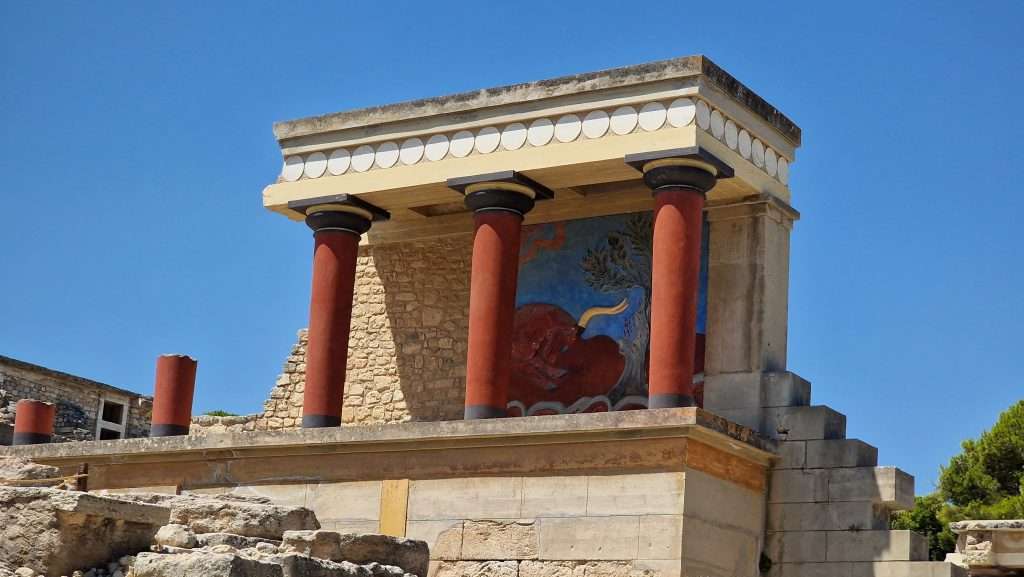
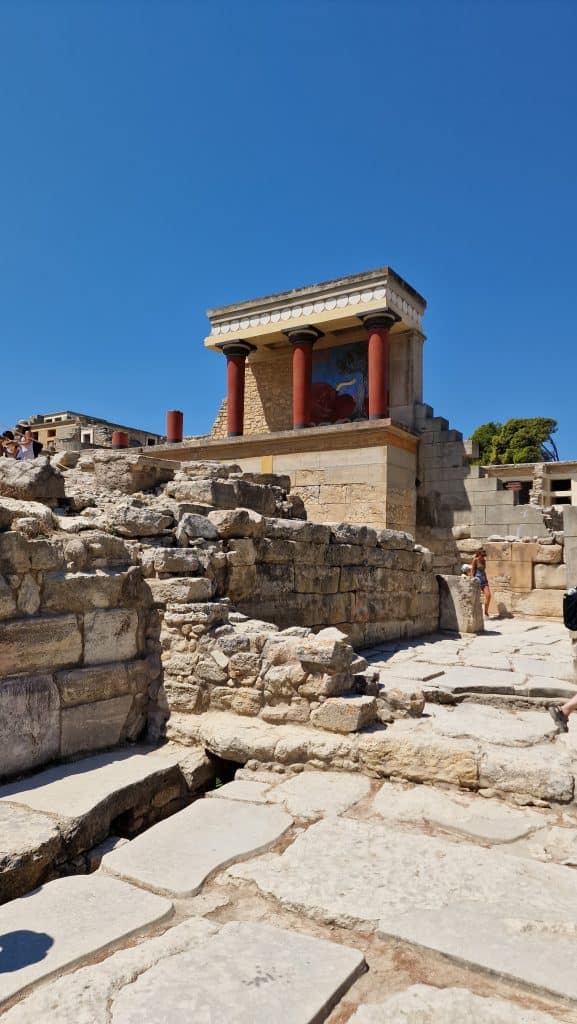

He also found the ancient parts of the large painting “the hunt for the bull” depicting a red bull with yellow horns facing north, towards the sea. In front of him is an olive tree and there is a red net with blue dots that is falling over his back to catch him.
This too is a relief painting like that of the prince of lilies. This fresco is very beautiful as it is rich in details, especially regarding the bull’s head which is very expressive.
In front of this veranda, there was another, of which we have today only the base. These two verandas were like two balconies from which you could have a beautiful view of the sea. They were 2 views from which the guards could control the entrance.
However, this theory is not accepted by British school archaeologists, who view the Minoites as peaceful, the palace as open, and there being no control. This theory is based on the fact that no weapons or bastions have ever been found at Knossos. According to them, these were just balconies to have a nice view and enjoy the panorama.
Knossos vs. Other Sites: The Real Reason to Visit
If you were to compare the ruins of Knossos to other astonishingly authentic archaeological sites—like the well-preserved cities of Pompeii or Herculaneum—I must be transparent: Knossos doesn’t compare in terms of pure physical originality.
However, the magic of Knossos lies in its narrative history. This is why I poured so much detailed history into this article. The site’s significance is its story. When you place it within a broader vacation context, exploring the history and culture of the Minoans—not just looking at a beach—it adds immense value to your trip to Crete. It transforms your holiday from a ‘fantastic, but generic beach trip’ to a deep dive into an island rich with civilization and mythology.
Completing Your Day in Crete
Plan for about half a day for the palace visit itself. Since we had our car, we were able to start early at Knossos, finish by mid-day, and then use the rest of the afternoon to visit the Archaeological Museum of Heraklion—which is a must-do to see the original frescoes—and then continue exploring other beautiful cities like Chania.
Heraklion Archaeological Museum
During the visit to Knossos, the guide will refer several times to the Archaeological Museum of Heraklion as the original frescoes and other important artifacts found in Knossos are kept here in the museum.
For this reason, it is useful to visit the Archaeological Museum of Heraklion after the visit to Knossos: in this way, your visit will be more complete and you can further deepen your knowledge of the Minoan civilization.
At the Knossos ticket office, they sell the combined ticket for the excavations of Knossos and the Archaeological Museum of Heraklion.
Knossos in Context: Comparing Crete’s Legacy with Mykonos and Rhodes
Having explored the treasures of Crete, Mykonos, and Rhodes, we can place Knossos within a broader framework of the Greek island experience. Each island offers a unique blend of history, adventure, and beauty, but they differ significantly in their archaeological appeal:
Crete (Knossos): The Iconic and Accessible Legend
Crete’s defining feature is its deeply rooted history, centered around the iconic and universally famous Knossos Palace. It carries the weight of mythology (the Minotaur’s Labyrinth), making it intellectually fascinating. Its major logistical advantage is its proximity to Heraklion, making it easy to access by car, though it remains slightly removed from the city center, offering a focused archaeological visit.
Mykonos (Delos): The Authentic Adventure
In contrast, Mykonos offers the nearby sanctuary of Delos. Here, the experience is more adventurous: you must take a boat to reach the isolated island. Delos preserves much more of its original, authentic ruins compared to Knossos, making it a compelling site for those seeking raw archaeology. Like Knossos, Delos is exposed, and the heat and lack of shade are factors that must be planned for.
To delve deeper into the raw, adventurous side of Greek archaeology, you can read our full guide on visiting the island of Delos near Mykonos:
Historical things to do in Mykonos: The ancient island of Delos
Rhodes (Lindos): History with a View
Rhodes offers a different dimension with the Acropolis of Lindos. While rich in history, Lindos provides a stunning, multi-sensory experience. From the high point of the Acropolis, you don’t just see the history; you witness a breathtaking panorama of the sea, the beautiful beach below, and the coastline. We visited Lindos in October, which was fantastic and helped us avoid the intense summer heat.
To see more of this unique historical site and natural beauty, read our detailed guide on visiting the Acropolis of Lindos:
Acropolis of Lindos: History and Visit Guide
The common thread across all these incredible islands is the necessity of good planning if traveling during peak summer. They are all islands full of incredible discoveries, valuable both for their historical depth, their adventure factor, and their sheer natural beauty.
The Golden Rule: Maximizing Beach Time and Sightseeing
A final piece of advice based on our travels to Crete and Rhodes (and even Mykonos, to a slightly lesser extent): these islands offer fantastic opportunities for swimming and beach time well beyond the typical summer. If you are planning a holiday where you want to comfortably visit ancient sites and enjoy the sea, consider traveling in September or October.
The sea remains warm, but the scorching heat we experienced in August subsides, allowing for a much more pleasant sightseeing experience, as we found during our visit to Lindos in October. These months are truly ideal for balancing the historical adventure with the natural beauty and crystal-clear waters.
Crete is Vast: The Start of a Grand Exploration
A crucial factor to remember when visiting Knossos is the sheer size of Crete. Compared to islands like Mykonos or Rhodes, Crete is far more extensive, meaning there is a massive amount to see and explore beyond Heraklion and Knossos—from remote beaches and mountain villages to historical towns like Chania. Your visit to Knossos is truly just the beginning of a grand adventure across this diverse island.
To plan the rest of your trip and discover the best beaches and historical sites across the entire island, consult our complete guide: